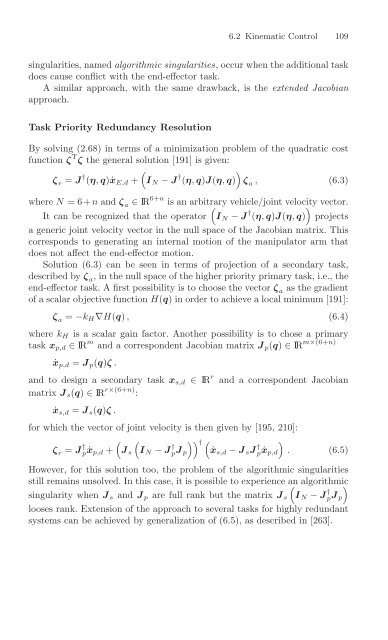Underwater Robots - Gianluca Antonelli.pdf
Underwater Robots - Gianluca Antonelli.pdf
Underwater Robots - Gianluca Antonelli.pdf
Create successful ePaper yourself
Turn your PDF publications into a flip-book with our unique Google optimized e-Paper software.
6.2 Kinematic Control 109<br />
singularities, named algorithmic singularities, occur when the additional task<br />
does cause conflict with the end-effector task.<br />
Asimilar approach, with the same drawback, isthe extended Jacobian<br />
approach.<br />
Task Priority Redundancy Resolution<br />
By solving (2.68) in terms of aminimization problem of the quadratic cost<br />
function ζ T ζ the general solution [191] is given:<br />
ζ r = J † �<br />
( η , q ) ˙x E,d + I N − J † �<br />
( η , q ) J ( η , q ) ζ a , (6.3)<br />
where N =6+ n and ζ a ∈ IR 6+n is an arbitrary � vehicle/joint velocity vector.<br />
It can be recognized that the operator I N − J † �<br />
( η , q ) J ( η , q )<br />
projects<br />
ageneric joint velocity vector in the null space of the Jacobian matrix. This<br />
corresponds to generating an internal motion ofthe manipulator arm that<br />
does not affect the end-effector motion.<br />
Solution (6.3) can be seen in terms of projection of asecondary task,<br />
described by ζ a ,inthe null space of the higher priority primary task, i.e., the<br />
end-effector task. Afirst possibility istochoose the vector ζ a as the gradient<br />
of ascalar objective function H ( q )inorder to achieve alocal minimum [191]:<br />
ζ a = − k H ∇ H ( q ) , (6.4)<br />
where k H is ascalar gain factor. Another possibility istochose aprimary<br />
task x p,d ∈ IR m m × (6+n )<br />
and acorrespondent Jacobian matrix J p ( q ) ∈ IR<br />
˙x p,d = J p ( q ) ζ .<br />
and todesign asecondary task x s,d ∈ IR r and acorrespondent Jacobian<br />
matrix J s ( q ) ∈ IR r × (6+n ) :<br />
˙x s,d = J s ( q ) ζ .<br />
for which the vector of joint velocity isthen given by [195, 210]:<br />
ζ r = J † p ˙x � �<br />
p,d + J s I N − J † �� † �<br />
p J p ˙x s,d − J s J † p ˙x �<br />
p,d . (6.5)<br />
However, for this solution too, the problem ofthe algorithmic singularities<br />
still remains unsolved. In this case, it is possible to experience an � algorithmic<br />
singularity when J s and J p are full rank but the matrix J s I N − J † �<br />
p J p<br />
looses rank. Extension of the approach to several tasks for highly redundant<br />
systems can be achieved bygeneralization of (6.5), as described in [263].






